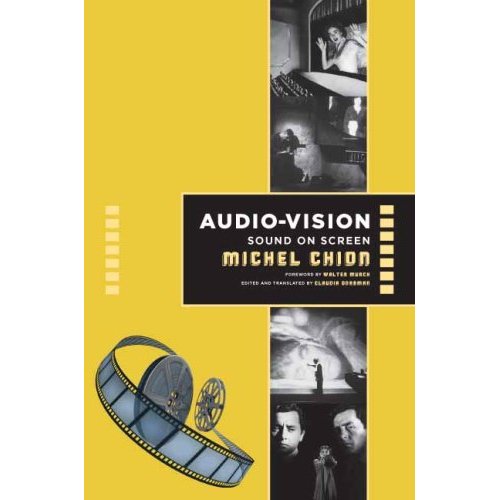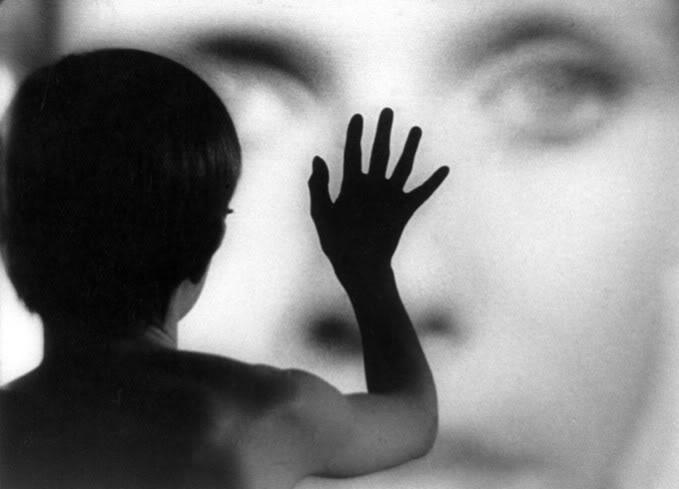From the Winter, 1995 issue of Cineaste. — J.R.
Audio-Vision: Sound on Screen
by Michel Chion. Translated and edited by Claudia Gorbman; Introduction by Walter Murch. New York: Columbia University Press, 1994, 239 pp., illus., Hardcover: $93.00; Paperback: $23.85.
Eighteen years ago, during my first quarter of film teaching, I terminally alienated some of my students in a lecture course on film esthetics with the following lesson in materialism. First I showed them Buñuel and Dali’s silent Un chien andalou several times, each time with a radically different musical accompaniment. Then I asked them on a quiz whether the statement, “The use of different kinds of music to accompany a silent film changes the film profoundly,” was true or false. Afterwards I explained to them that such a statement could only be false because the film remained the same regardless of whatever music accompanied it; the music changed only the way we looked at and ‘read’ the film, not the film itself.
I’m not recommending this as a teaching method, especially if one wants one’s contract renewed (mine wasn’t), but I’m bringing it up to illustrate the degree to which a certain amount of mystification about the relationship between image and sound is firmly entrenched in the way we think about film. From this standpoint, the first book in English by Michel Chion, a French film analyst specializing in sound, must be recognized as an important landmark. Designed as a “capstone” to Chion’s three previous books about film sound (La Voix au cinéma; Le Son au cinéma; La Toile troupée, la parole au cinéma), as well as a development of some of the passing ideas found in some of his other works (such as books devoted to Jacques Tati and David Lynch), Audio-Vision offers a great deal of fresh and rigorous thinking about the complex relations between sound and image that automatically overturns many of our unexamined, everyday assumptions. Cogently and provocatively introduced by sound designer Walter Murch, and carefully translated and edited by Claudia Gorbman (who has written helpfully about the book elsewhere, in Wide Angle, Vol. 15, No. 1), it indeed challenges so many of the standard ways that this subject is treated that it often threatens to invalidate most previous approaches — above all those approaches that implicitly assume our perceptions of sound and image are somehow independent of one another rather than crucially interactive and codependent.
As a way of demonstrating how the ear leads the eye and vice versa, Chion usefully begins with two modest proposals: that we analyze the opening avant-garde sequence of Bergman’s Persona with and without the sound, and a characteristic naturalistic sequence on the beach in Tati’s Mr. Hulot’s Holiday with and without the image. In the first case, he observes that, without sound, not only does the first sequence of Persona lose its rhythms, its unity, and its meaning; it also looks different — a “shot” of a nail driven into a hand becomes three separate shots, and a narrative exposition of bodies in a morgue, without the sound of dripping water, becomes a disconnected series of stills without reference to either space or time. In the second case, the apparent boredom, discomfort, and inertia of vacationers witnessed on a beach becomes the sound of lively children enjoying themselves without the image to “mislead” us.
In both cases, Chion argues, we are responding to “synchresis” — one of his many coinages in the book, in this case a combination of “synchronism” and “synthesis” — which is “the spontaneous and irresistible weld produced between a particular auditory phenomenon and visual phenomenon when they occur at the same time,” and which “results independently of any rational logic.” As another example, he cites how, in The Empire Strikes Back, a cut between a closed door and an open one is misperceived as a door sliding open whenever it’s accompanied by a dynamic, pneumatic sound effect.
The bounty of fresh information available from this analysis transforms not only our sense of the function of sound but also our understanding of the functions of its absence. Chion shows how certain montage sequences in silent films, such as close-ups of grinning or scowling faces, show events that can be read as either simultaneous or successive, but once we hear collective laughing or booing over them, “they seem magically to fall into a linear time continuum.” (The company dinner at the beginning of Renoir’s Le Chienne is cited as an awkward if interesting example of an early talkie where the differences between simultaneity and succession weren’t yet fully worked out.)
There are many such glancing insights threaded through Audio-Vision, and if the book as a whole winds up disappointing some of the expectations aroused by these observations, this is because Chion often has a tendency to rush past them rather than explore their implications. After pointing out that definition in contemporary sound recording is often mistakenly taken as proof of fidelity, in a chapter entitled “The Real and the Rendered,” Chion offers a valuable analysis of the idealistic (as opposed to realistic) properties of George Lucas’s THX sound, stripped of distortions, “secondary vibrations,” and reverberations that we would hear in real life, and concludes, “The big THX theaters no longer give us collective sound in the old style; it’s inflated personal stereo sound.” The ideological implications of such an observation are vast, telling us a great deal about what happened to the social experience of filmgoing over the past half century, but rather than ponder such an issue, Chion promptly moves on to the next item in his crowded agenda. As Gorbman noted in Wide Angle, Chion “shows little interest in examining sound’s implications in the construction of gender, nor is he concerned here with any other kind of textual politics.”
There’s also a certain French love of paradox and provocation here — such as the repeated assertion that there is no such thing as a soundtrack — that may disconcert as much as it clarifies, despite the fact that Chion works overtime in trying to justify such a remark. (What he mainly has in mind is the assumption that the sounds in a given film “constitute a coherent entity” in the same way that images do: “The image track owes its being and its unity to the presence of a frame, a space of the images in which the spectator is invested,” but the sounds of a film, considered independently, “do not form an internally coherent entity” in the same fashion; moreover, there are no objective sound units that correspond to objective image units like shots.)
Some readers may balk as well at all the new terms that Chion has invented or adapted to describe his concepts. But the amount of fresh, lucid thinking found here more than justifies such minor difficulties. No one can emerge from this densely-packed volume without a deeper understanding of what sounds and images do to one another, and to ourselves in the process.



